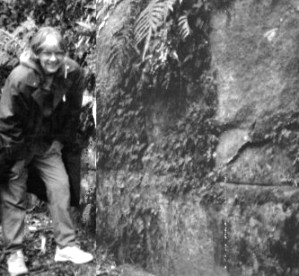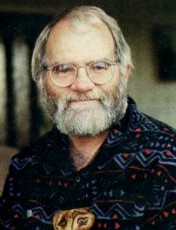

![]()
the Waitaha Nation
"The Waitaha nation goes back 2000 years. This wall is much older even than that" says Barry Brailsford, MBE,(author, the 'Tattooed Land', 'Greenstone Trails', 'Song of Waitaha', 'Song of the Stone') - commenting on the Kaimanawa Forest's ancient wall (above)
Did 200 tribes of the Waitaha Nation settle in NZ 2,000 years ago, and were they decimated by the Maori 800 years ago, in an eerie foretaste of the Maori massacre of the Moriori in the Chathams? In the early 1990's Doug Sutton, Auckland University archaelogist, suggested that human beings were living in New Zealand millenia before Maori.
The image above shows blocks, some weighing tonnes, deep in the Kaimanawa Ranges. The four visible stones are a uniform 1.9 metres wide by 1.6 metres tall, and 1 metre wide. The faces are smooth, with no saw or adze marks, and the interfaces are knife-blade thin.
Further up the hill, the tops of other stones protrude (see the graphic below) and where the blocks would be buried creates a uniform structure, with a touchstone before the tiered structure.
The "Song of Waitaha" was a release to the world of secret traditions, geneology, and history, as told to the author by Waitaha elders, asserts Barry Brailsford.
Brailsford says he had to earn the right. Before beginning work on the book he had to lead a selected team of people across the Southern Alps to reopen old Waitaha greenstone trails closed for 130 years.

He had to undertake journeys which took him into the North American desert to light "trail fires" (which resulted in Wallace Black Elk, leader of the Sioux people, turning up unexpectedly on Mr Brailsford's Christchurch doorstep) and, on another journey, deliver greenstone to the 12 American Indian nations. He also visited megalithic sites in England, Scotland and Wales.
"Until now we have hidden our beginnings, and all that followed, in the shadows. In this way we protected our knowledge in the silence of the Whare Wananga, the School of Learning of Waitaha."
"For it has been decided it is time for our treasures to be brought into the light."
"We do this for the children, and their children, and all who call this land home."
"We are of Tane Matua, and we follow Rongo Marae Roa, the God of Peace."
"In the wisdom and aroha (love) of those words, we say: `Let the sacred kete (basket containing sacred knowledge) be opened for the ancestors to speak again. Let the ancient karakia and waiata be heard throughout the land. Welcome to the trails of the peoples of the Nation of Waitaha. May you journey far in peace and understanding."
The history of the Nation, according to the author, begins with a man, Kiwa and a woman, Hotu Matua, both great sailors/navigators. They meet at Waitangi Ki Roto, or Easter Island.

"Kiwa was of the Uru Kehu people, Hotu Matua of the Maoriori. He was short and fair skinned, while she was tall and dark; his hair was fired by the colours of the sun and hers the black of night; his eyes reflected the blue waters of the sea and hers the brown of the earth."
Eventually
they had a grandson, Maui,
"a nanakia child; one who
pushes against the wind, challenges the incoming tide, and asks questions
that probe behind questions never asked before. In his huge mind and soaring
spirit he faced the world with the courage and audacity to bargain with
the Gods for the benefit of the people."
Maui is well known in Maori tradition as the discoverer of New Zealand. The histories relate that he journeyed three times, not once, to New Zealand however, discovering in sequence the North Island, the South Island and Stewart Island - the fish, the waka and the anchor. Maui then returned to Easter Island, promising one day to return. For about 200 years the Waitaha travelled to New Zealand, each time leaving settlers, and then eventually a founding waka arrived with 175 people.
However, when elders foresaw the destruction of their peace-loving nation by later arrivals of Maori, and whole generations of their genealogy were to be "erased" -- the knowledge was not shared outside the Waitaha, to protect the sacredness of their ancestors from violence and warfare
The Waitaha comprised three different peoples: The Moriori, or Maeroero, who at the time were giants, over l.8m and superb gardeners, able to grow the kumara 1000 km further south than in its South American homeland.
Herries
Beattie describes them in Nga Waka Press Release I,
"... among the first, if not the very first, residents in the South
Island. They were here before Maui sailed round from Bruce Bay to Kaikoura
between the years 400-450 AD ... they were a kindly people, not bloodthirsty
or pugnacious, and timidly fled to the wilds before the advance of later
arrivals. They were musical and could play flutes and sing, and the smoke
of their fires marked their presence in out-of-the-way spots."
Then there were the Urukehu, a fair-skinned people also known as the Starwalkers who were skilled at reading the geometry of the stars and were the navigators guiding the people to this land; and the Kiritea or Stone people, who came from Asian lands and who carried the greenstone over mountain passes.
The Waitaha, claiming that they pre-empt the Maori of course challenge the Waitangi Tribunal. Waitaha leader Rangimarie Te Maiharoa says the settlement will "extinguish customary rights and aboriginal title of our people".
Then in 1997 an ancient carving now being held at the Dargaville Maritime Museum, in Northland, was announced to the public. The carving - kept secret since its discovery six years ago - was restored at Auckland University.
Museum curator and renowned historian Noel Hilliam says the rare 2.7m female carving is Waitaha and was found in sand dunes at North Head on Kaipara Harbour by a local woman. Patrick Ruka, Waitaha kaumatua, named it Pouto Ki Rongo Maraeroa.
Particularly tantalising is a buried Waitaha village in the Kaipara dunes - it first made an appearance several years ago when a fierce storm temporarily shifted sand. Only to return and cover it up again.
Barry Brailsford has said simply,
"Ten years ago when I was
called to write the story of Waitaha I was told by the elders that I would
be challenged by Maori who did not want the story revealed, by Pakeha in
the academic world who would not believe it, and by others who would walk
with their own agendas."
Here is such an alternative view, arguing the misappropriation of indigineousness by Makere Harawira
This
Web Directory will always be dynamic ~
all details are flexible and changing